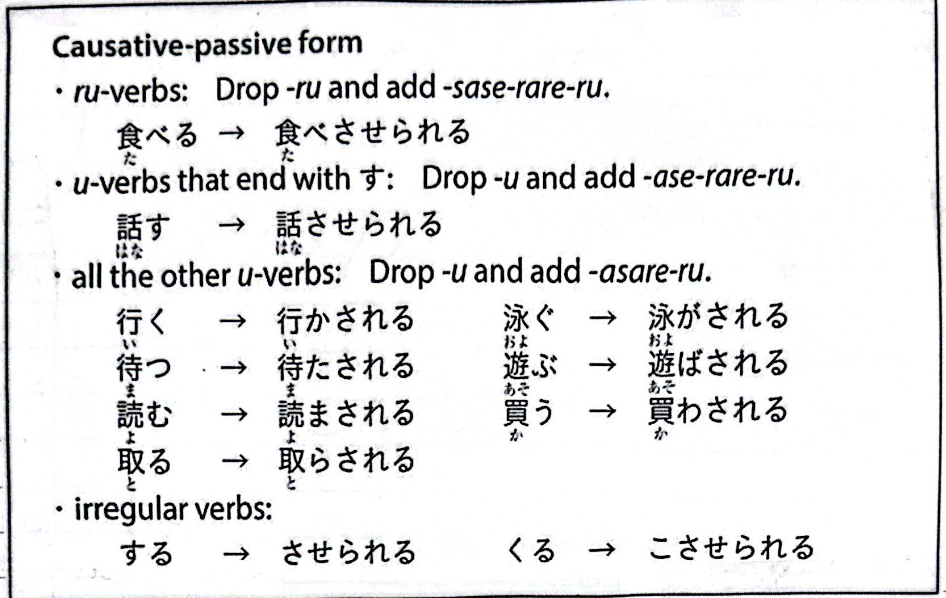L.23 Grammar Structures (WITH examples)
1/35
There's no tags or description
Looks like no tags are added yet.
Name | Mastery | Learn | Test | Matching | Spaced |
|---|
No study sessions yet.
36 Terms
I was forced to carry a bag by my boss.
私わ部長にかばんをはこばされました。
I was forced to sing a song.
歌を歌わされました。
I am always forced to eat my vegetables.
いつもやさいを食べさせられました。
causative-passive conjugation rules
ru-verbs: drop -ru and add -sase-rare-ru
u-verbs that end w/ す: drop -u and add -ase-rare-ru
all the other u-verbs: drop -u and add -asare-rus
する —> させられる
来る —> 来させられる

causative-passive form sentence structure
[puppet] は [puppet master] に [action]
(the subject before は here is the same as a regular, noncausative, nonpassive sentence; aka the opposite of a passative or causative sentence).
〜ても sentence structure
[A (te-form)] + も + [B]
We will have a BBQ, even if it rains.
雨がふっても、バーベキューをします。
I will not turn on the A/C, even if it’s hot.
あつくても、アイコンをつけません。
〜ても conjugation structure
verbs: te-form (negative: なくても usually)
な-adj. and nouns: use でも instead of ても (UNLESS negative: じゃなくても usually works… ish)
い-adj.: く trick (adverb form… ex: さむくても) (negative: くなくても usually)
I have decided to buy a new house.
新しい家を買うことにしました。
I won’t complain from now on.
これからもんくを言わないことにします。
I have decided to continue my study of Japanese/Japanese studies.
日本お勉強を続けることにしました。
I have decided to get up early and go jogging.
早く起きして、ジョッギングすることにしました。
I have made it a rule/habit to get up early and go jogging.
早く起きして、ジョッギングすることにしています。
“have decided to do” structure
[V(short form)] + ことにする
〜ことにしました —> “I have decided to do [thing]”
〜ことにしています —> “I make it a habit/rule to do [thing]”
〜ことにします —> “I have just now decided to do [thing]”
〜ことにしよう —> “I have decided to do [thing] [after much discussion]”
[After discussion], we have decided to take a trip abroad this summer.
今年の夏は海外旅行に行くことにしよう。
I have made it a rule/habit not to talk behind someone’s back.
私は悪口を言わないことにしています。
“until X” sentence structure
[V(short form)] + まで
Note: the verb here must always be in positive short form, never negative.
Until it clears up [outside], I will wait in the café.
はれるまで、カフェで待ちます。
I won’t quit baseball until [my team] wins a championship.
ゆうしょうするまで、やきゅうをやめません。
“how to do X” sentence structure
[V(masu stem)] + 方
“how to do X” conjugation rules
if the verb is a する verb、then the を before the verb becomes a の. Additionally, add a の before the する. Then, the します changes to し方. Regular verbs that involve を simply have the one を turned into の.
(ex.: 日本語の勉強のし方 —> how to study Japanese).
how to swim
およぎ方
how to use chopsticks
はしの使い方
“the way people think” or “how to think [about something]”
考え方
how to read kanji
漢字の読み方
how to book a hotel room
ホテルのよやくするのし方。
how to study Japanese
日本語の勉強のし方
There are many ways to eat this vegetable.
このやさいの食べ方はいろいろあります。
Could you please teach me how to write this kanji? [formal]
この漢字の書き方を教えていただきませんか。
How to go to the airport
空港の行き方
The way Tanaka eats ramen is interesting.
田中さんおらめんお食べ方はおもしろいです。
I don’t know how to use this app.
このアプリの使い方がわかりません。
Please explain how to order.
ちゅうもんのし方をせつめしてください。
〜ために sentence structure
[noun] + の + ために + [rest of sentence]
What do you do for your health?
けんこうのために、何をしていますか。